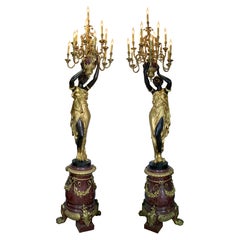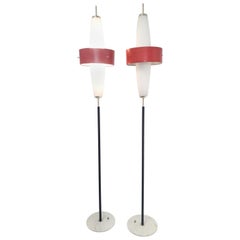
Pair of Putti Torcheres by A. Durenne & A-E Carrier-Belleuse, France, Circa 1880
View Similar Items
Want more images or videos?
Request additional images or videos from the seller
1 of 10
Pair of Putti Torcheres by A. Durenne & A-E Carrier-Belleuse, France, Circa 1880
About the Item
- Creator:Albert-Ernest Carrier-Belleuse (Sculptor),A. Durenne (Maker)
- Dimensions:Height: 43.31 in (110 cm)Width: 14.97 in (38 cm)Depth: 9.85 in (25 cm)
- Sold As:Set of 2
- Materials and Techniques:Iron,Cast
- Place of Origin:
- Period:
- Date of Manufacture:circa 1880
- Condition:Wear consistent with age and use.
- Seller Location:PARIS, FR
- Reference Number:Seller: 1508/331stDibs: LU3860313613732

About the Seller
4.9
Vetted Seller
These experienced sellers undergo a comprehensive evaluation by our team of in-house experts.
Established in 1997
1stDibs seller since 2018
73 sales on 1stDibs
Associations
International Confederation of Art and Antique Dealers' Associations
More From This SellerView All
- Pair of Bronze Putti Torcheres Attributed to v. Paillard, France, Circa 1870By Victor PaillardLocated in PARIS, FRA pair of two patina bronze torcheres attributed to V. Paillard. Each modelled as a pair of putti holding aloft a large foliate shaft issuing eleven berried-acanthus scrolled branche...Category
Antique 1870s French Napoleon III Floor Lamps
MaterialsBronze
$182,285 Sale Price / set55% Off - Pair of Bronze Torchères by E.Colin after a Model by A.Carrier, France, c. 1900By Albert-Ernest Carrier-Belleuse, Colin, ParisLocated in PARIS, FRInscribed A. Carrier and Anc. Mon Colin éditeur – fondeur, Paris Measures: Torchère height 193 cm (75.9 in.), base height 29 cm (11.4 in.), diameter base 40 cm (15.7 in.). 2 torchères + 2 bases Exceptional pair of "Night" and "Day" female torchère-holders, made in dark patinated bronze. Each dressed with antique style drapes, and holding up a gilt-bronze five light-arms candelabra. Day, bareheaded and with braided hair ; Night, the head covered by her coat and holding poppy flowers and fruits symbolizing sleep. Standing on a molded pedestal. These female torchère-holders repeat a common theme created by Carrier-Belleuse, what model for one of the two shapes was presented for the first time at the Paris Universal Exhibition of 1867. It was then used on a big clock made in collaboration with G. Viot company. The bronze figure holds a large pendulum instead of a candelabrum. (reproduced and commented in 1851-1900 Le arti decorative alle grandi Esposizioni Universalli, D. Alcouffe, Idea Libri, p° 78, n° 256.) Albert-Ernest Carrier-Belleuse (1824-1887), nick-named the “Clodion of the 19th century”, was a very prolific sculptor, treating his decorative objects and his portraits with equal naturalistic rigor, full of charm and life. He entered the Paris Fine-Arts school in 1840, where he studied sculpture under David d’Angers. From the early 1860s, he won success with his sculptures presented at the French Artists Salon and particularly during the 1867 Salon, where he was awarded a “médaille d’honneur” and the “Légion d’honneur” for his Messiah. The “new” Paris redesigned by the Baron Haussmann during Napoleon IIIrd’s reign, commissioned many of Carriere-Belleuse’s masterpieces: at the Louvre palace with the high-relief “L’Abondance” on the Flore Pavilion (1865), or the sumptuous decoration made for the most famous Parisian palace on the Champs-Elysées Avenue, owned by the Marchioness of Païva. But it is especially with the torchères-statues of the large staircase of the Paris Opera house (1873), recently built by Charles Garnier, that Carrier-Belleuse meets a huge success with the Parisian public. In the catalogue of the 1878 Universal Exhibition an art critic praised Carrier-Belleuse and added: “Even the English come from London to ask him to work for them”. His busts, nudes, group compositions as well as his candelabras, vases and clocks, all chased remarkably, had a considerable success during the Second Empire. Emile Colin, a renowned founder installed since 1843, No. 29 Sévigné Street in Paris, cast as soon as 1855 for the most well-know masters of France sculpture, such A.E. Carrier-Belleuse (Le Zouave), J. Pradier (Les Trois Grâces, Vénus consolant l’Amour) or J.B. Carpeaux since 1875 (L’Enfant au cor), as well as the famous Parisian silversmith Christofle. Colin used to stamp his bronzes of the mention “Emile Colin & Cie” from 1882 until 1898. That mark became later “M. Colin & Cie” from 1898 until 1906, then “Ancienne Maison Colin...Category
Early 20th Century French More Lighting
MaterialsBronze
- Pair of Neo-Greek Bronze Floor Lamps by F. Barbedienne, France, circa 1860By Ferdinand BarbedienneLocated in PARIS, FRHeight without/with lampshade : 168/185 cm (66,1 / 72,8 in.) ; Base : 43 x 43 cm (16,9 x 16,9 in.) Beautiful pair of neo-Greek floor lamps in bronze with double patina, composed of cylindrical lamps, decorated on the body with a rotating frieze representing women dressed in the Antique style weaving and spinning, surmounted by lampshades with cut sides in red pleated silk with golden braid. They are placed on pedestals from which hang thin chains attached to the slender shaft decorated with stylized leaves and flowers, resting on a tripod base decorated with large palmettes and ending in lion’s paws. The stylistic repertoire used here, composed in particular of palmettes, masks, and nymphs, evokes Greek Antiquity, as does the reuse of forms of furniture and objects such as tripods and antique vases. The rediscovery in the 18th century of the archaeological remains of Pompeii and Herculaneum allowed artists of all disciplines to draw inspiration from Antiquity while reinterpreting it. This trend did not fade and, in the 19th century, many personalities fitted out their interiors with neo-Greek furniture, as was the case for the Maison Pompéienne built in 1856 by the architect Alfred Normand (1822-1909) for Prince Napoleon, or Empress Eugénie who bought from the Maison Barbedienne pedestals inspired by antique tripods. Related work : Pedestal model presented by Maison Barbedienne at the Universal Exhibition in Paris in 1855. On this occasion, Empress Eugénie bought it for her bathroom in the Château de Saint-Cloud. This model pleased the Empress so much that she ordered two other pairs in 1858 for her boudoir in the palaces of Compiègne and Fontainebleau. (see photo attached) Photo showing a floor lamp similar to ours in Empress Eugénie’s bedroom in the Château de Compiègne (Oise), in Architecture intérieure et Décoration en France des...Category
Antique 1860s French Greek Revival Floor Lamps
MaterialsBronze
- Pair of "Bamboo" Stands attr. to H. Cahieux & F. Barbedienne France, circa 1855By Henry Cahieux and Ferdinand BarbedienneLocated in PARIS, FRA similar model presented at the 1855 Paris Universal Exhibition Total height : 154 cm (60 5/8 in.) ; Width : 33 x 33 cm (13 x 13 in.) Cup : height 17 cm (6 ¾ in.) Beautiful pair of bronze stands also named Bamboo candelabra. Each rests on three claw feet adorned with lion heads and separated with palms. A bamboo shaped shaft arises from this tripod and is topped with three buds supporting a circular red griotte marble top on which stands a cup in the Ancient style decorated with ivy. The sobriety of the decoration enhances the quality of the bronze cast and the patina shades. The small chains falling from the top animates this work of a sleek design. The model : The design of these stands, inspired from Ancient tripods, is a well-known model in Ferdinand Barbedienne’s production as it was reused many times by the bronze-caster. Designed by the head-decorator Henri Cahieux, this model was edited by the Barbedienne Company as soon as 1855, named Ancient candelabra lamp-holder h. 1m35 and was sold 440 francs. From 1875, these stands were commercialised under the name Bamboo candelabra, tripod, lamp-holder and were offered in three heights : 1m90, 1m70 and 1m35. This model of stand could then be found in all catalogues of the Barbedienne Company. This pair of candelabras allows us to see how F. Barbedienne offered during decades a range of furniture from the designs of his decorator. This type of stand could be seen in different interior decorations of the Second Empire A model similar to ours was presented by the Barbedienne Company at the 1855 Universal Exhibition. For this occasion Empress Eugénie bought it for her toilet at Saint-Cloud Castle. A watercolor by Fortuné de Fournier made in 1860 shows them, set on both sides of a cheval mirror made by the Fourdinois Company. (see photo attached) This model pleased the Empress so much that she ordered two other pairs in 1858 for her boudoirs at Compiègne and Fontainebleau Palaces. Otherwise similar stands took place in the Pompeiian house built in 1856 by the architect Alfred Normand (1822-1909) for Prince Napoléon. Several pictures and engravings of this house show us these candelabras used...Category
Antique 1850s French Greek Revival Floor Lamps
MaterialsGriotte Marble, Bronze
- Pair of Neo-Greek Floor Lamps Attributed to G. Servant, France, Circa 1870By Georges Emile Henri ServantLocated in PARIS, FRRare pair of Greek style floor lamps made in patinated bronze attributed to G. Servant, each surmounted of a frosted glass globe engraved of stars and a Greek motif frieze. The body of the vase, decorated with Greek style patterns such as palmets, Greek motif frieze and water leaves, stands on a shaft decorated with deer heads. Fine chains are connected to a delicate butterfly. The set is based on tripod legs with lion claw feet alternating large palmets. Height : 183 cm (72 in.) ; 213 cm (83 3/4 in.) with glass shades ; Diameter : 43 cm (19 2/3in.) Georges Emile Henri Servant (1828-c.1890), who took over his father in 1855 at their foundry, rue Vieille-du-Temple, in Paris, specialized in the production of neo-Egyptian style clocks, very popular in France since 1860’s, and also the making of Greek style decorative objects. He drew considerable attention to the high quality of his bronzes at the 1855 Paris Universal Exhibition and then at the 1862 London Exhibition. At this time Servant exported up to 40% of his production, principally to the United States, where for instance, his clocks were sold with great success by Louis Tiffany Inc. or Hamann & Roche of New York. But his success came really at the 1867 Paris Universal Exhibition, where he was awarded a gold medal for his neo-Greek and Egyptian works (Les Merveilles...Category
Antique 1860s French Greek Revival Floor Lamps
MaterialsBronze
- Pair of "Indian Slave" Torcheres by Toussaint & Barbedienne, France, circa 1850By Achille Collas, François-Christophe-Armand Toussaint, Ferdinand BarbedienneLocated in PARIS, FRSigned Ad Toussaint 1850 and F. Barbedienne Fondeur Stamped Achille Collas Réduction Mécanique Torcheres – height : 148 cm (58 1/4 in.) ; width : 34 cm (13 1/3 in.) Pedestals – ...Category
Antique 1850s French Napoleon III More Lighting
MaterialsCrystal, Bronze
You May Also Like
- Pair of Monumental French Gilt and Patinated Bronze and Rouge Marble TorcheresBy Albert-Ernest Carrier-BelleuseLocated in Los Angeles, CAA pair of large French parcel-gilt patinated bronze and rouge marble 13-light torchieres after the models by Albert-Ernest Carrier-Belleuse (1824-1887). Each torchere modeled as a c...Category
Early 20th Century French Rococo Floor Lamps
MaterialsMarble, Bronze
- Rare Pair of Torchères by StilnovoBy StilnovoLocated in Los Angeles, CARare pair of vintage Italian torchère floor lamps with frosted glass shades and red enameled metal bands, mounted on marble base / Designed by Stilnovo circa 1950s / Made in Italy Me...Category
Vintage 1950s Italian Mid-Century Modern Floor Lamps
MaterialsMarble, Brass
$14,500 / set - Rare Pair of Torchères by StilnovoBy StilnovoLocated in Los Angeles, CARare pair of vintage Italian torchère floor lamps with frosted glass shades and red enameled metal bands, mounted on marble base / Designed by Stilnovo circa 1950s / Made in Italy He...Category
Vintage 1950s Italian Mid-Century Modern Floor Lamps
MaterialsMarble, Brass
$14,500 / set - Important Pair of French Patinated Bronze Torchères by Mathurin MoreauBy Mathurin MoreauLocated in New York, NYMaker: Mathurin Moreau (1822-1914) Origin: French Date: Circa 1900 Dimension: 69 x 15 1/2 inchesCategory
Antique 19th Century French Torchères
MaterialsBronze
- Pair of Chrome Deco TorcheresLocated in Hudson, NYPair of chrome deco torcheres (floor lamps).Category
20th Century American Art Deco Floor Lamps
$10,000 / set - Pair of Silver Plated TorcheresLocated in New York, NYPair of circa 1940's English silver-plated torcheres with uplight and with finely etched bases. Measurements: Total height: 64" Diameter: 10"Category
Vintage 1940s English Neoclassical Floor Lamps
MaterialsSilver Plate
$12,000 / set
Recently Viewed
View AllMore Ways To Browse
Outdoor Antique Lighting
Antique Cast Iron Furniture Outdoor
Second Empire Clock
Bridge Floor Lamp
Bronze Lamps Nude
Bridge Lamps
Antique French Lamp Empire
French Putti Lamp
Cast Iron Clocks
Pair Iron Torcheres
Floor Iron Candelabra
Iron Floor Candelabra
Iron Candelabra Floor
Antique Green Floor Lamp
Black Horse Lamp
Antique Picture Holder
Antique Arts And Crafts Clocks
Antique Arts And Crafts Clock

















